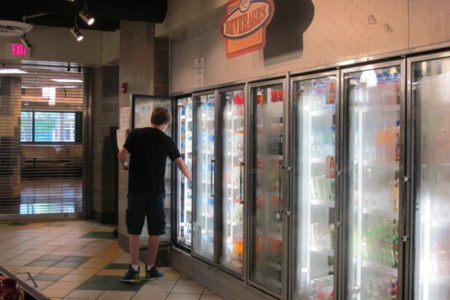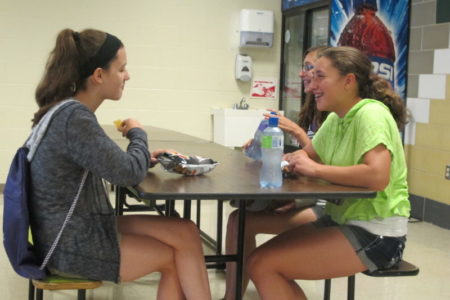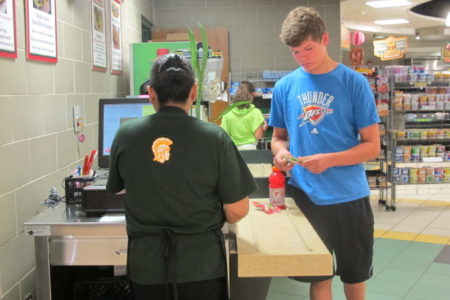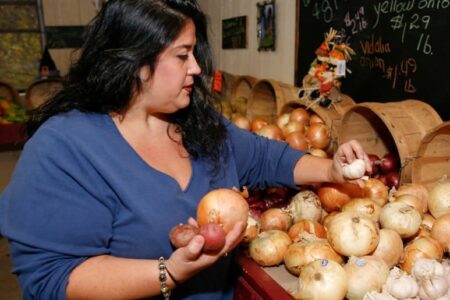Share On Social!
During the school day, lunch time is a chance for busy students to take a break, relax with friends, and refuel. Refueling with healthy foods and drinks is vital.
At two high schools in the Chicago suburbs, a concerned school board member saw a disconnect between the emphasis on healthy eating at lunch and the large sugary drink selection in cafeterias.
The concern turned into a semester-long discussion between students, food services managers, and administrators that resulted in a new beverage policy for the school district that reduced the number of unhealthy drinks and marketed healthy ones in creative ways.
The Issue of Sugary Drinks
Awareness/Learn: The Latino student population is small—but rapidly growing—at Glenbrook High School District 225, which is commonly known as “the Glenbrooks” because it includes two high schools, Glenbrook North and Glenbrook South, just 20 miles north of Chicago.
The percentage of Latino students doubled in the past 10 years, district data shows.
The Glenbrooks recently transformed its cafeterias into a food court-style dining experience with many healthy lunch options, such as traditional favorites like made-to-order tacos, fajitas, fresh pastas, chopped salads and more, said Kim Ptak, the district’s director of operations and purchasing.

About 80% of food sold in the cafeteria is made from scratch.
“There’s an overall healthy theme going on throughout our cafeteria,” said Ptak.
But one thing hadn’t changed.
Sugary drink options still dominated cafeterias.
“We had Gatorade, we had root beer, we had Cherry Coke, vanilla Pepsi…every choice imaginable,” said Ptak, who compared beverage options at the two schools to a 7-Eleven corner store.
School officials acknowledged that choice is very important to students, but they were beginning to question the nutritional quality of the choices available to students at the Glenbrooks, Ptak said.
One concerned school board member in conjunction with some feedback from the administration team brought a simple question to Ptak and her colleagues: should we be offering all of this?
Frame Issue: In 2006, the American Beverage Association worked with public health officials to create school beverage guidelines, but because the Glenbrooks don’t receive funds from the federal lunch program, they aren’t required to meet the beverage standards.
“They are guidelines, but nothing we’ve been required to follow,” said Ptak.
So without an existing beverage policy in place, school board members decided it was time to work with the students and food vendors to create one.
“We decided we really wanted to look at the beverages and try to offer healthier options,” said Ptak.
Addressing the Issue of Sugary Drinks

Education/Mobilization: Students played a big role in remaking the cafeterias’ food environments.
Students were part of food committees at both Glenbrook North and Glenbrook South to review food offerings and vendors. The committees also included the manager of the district’s food services provider, Quest Food, a vice principal from each school, other faculty and staff, and Ptak.
The food committees at both high schools continue to meet four times a year.
At the December 2013 meeting, the topic switched from food to drinks.
“We wanted to work with the student population to reduce the number of sugar drinks that we have,” said Dr. Michael Riggle, the district’s superintendent.
At the meeting, the food providers said that more than 80% of students buy beverages at school, said Ptak, which gives the schools a big opportunity to encourage healthy drinking.
District administration asked the students to think about how they might encourage their peers to make healthier drink choices while at school.
Debate: Removing sugary drinks altogether wasn’t a popular idea with students, Ptak said.
“The overriding theme from the students was that they still wanted to see choices,” said Ptak, who noted that high-school students tend to value freedoms they didn’t have as younger students.
However, students wanted to see healthier drink options, and they were excited about marketing new healthy drinks in the cafeteria and displaying nutrition information so their peers could make an informed and hopefully healthy choice.
The students had some good ideas to let their peers know what’s in their drink, Ptak said.
Students suggested listing the number of calories and amount of sugar in terms of cubes found in the unhealthy drinks in charts next to the coolers. They also discussed using traffic light color labels—red, yellow, and green—to mark drinks that were full-sugar, lower-sugar, and no-sugar, respectively.
“More information will lead to better choices,” said Skip Shein, president of the district’s school board. “That’s what we’re teaching them to do. So let’s provide as much nutrition information as it is reasonable.”
Creating a Solution to the Issue of Sugary Drinks
Activation: The committees began to craft the new drink policy at meetings in spring 2014.

They decided that the policy should require 75% of the drink options at the two high schools to be healthy options.
“We want to get real creative with the 75% beverage mix,” said Ptak.
She and the students hoped that healthy yet unique drinks, like flavored waters and lightly sweetened sparkling water, would encourage students to choose drinks with less sugar.
Committee members hoped that placing these healthier beverages in the center of the cafeteria in big coolers would catch students’ eyes as they scanned the room for a lunchtime drink.
Additionally, the committee discussed placing the unhealthy drinks on the outsides of the cooler so they aren’t front and center.
Riggle also noted that the committees were tossing around the idea of reducing the portion size of the unhealthy sugary drinks—another way to subtly market the healthy drinks: more bang for your buck.
The students had some other marketing ideas, too.
They wanted to price the healthier drinks lower than their sugary counterparts—something Ptak said would give students another reason to pick healthy drinks over the sugary ones.
“We wanted to use the power of pricing,” she said.
Frame: In mid-June 2014, Ptak met with the nutrition services company and gave them the list of guidelines she, along with input from students and faculty, had created.
Once they look over the plan, they will make changes if necessary, and hand it back to the Ptak at operations and purchasing. Then she said they will loop back with the students to be sure the new policy meets of their expectations.
Change: Ptak expects the changes to roll out at both high schools when school doors open for the 2014-2015 school year. Some of these healthy changes include:
- Limiting sodas, juice, and regular Gatorade to 12-ounce cans only.
- Pricing the 12-ounce full-sugar drinks at $1.50, what a 20-ounce water bottle would cost.
- Removing many full-sugar soda options.
- Introducing unique healthy drink options, like sparkling water, artisan water, and low-sugar juices.
- Putting the healthy drinks front-and-center in cafeterias’ drink coolers, while leaving the more sugary options on the perimeter.
- Implementing an educational component, such as traffic light-colored nutritional labels, calorie and sugar posters, or both.
Sustaining a Solution to the Issue of Sugary Drinks
Implementation: Cafeterias at the Glenbrooks will offer less sugar in the 2014-2015 school year.
Ptak is confident that the student input throughout the process and the quality of the school lunch options will prevent students from leaving campus to buy junk food and soda.
“We feel that the great quality of the food in the cafeteria is what’s drawing them, the beverages are sort of secondary,” she said.
Once the school year gets underway, Ptak says they’ll get a better idea of how students feel about the new drink options—and the ones that will have been removed.
Quest tracks food and beverage sales; Ptak said currently sodas make up about 30% of all drinks sold.
“It’ll be interesting once this rolls out if there is a shift,” she said.
Sustainability: Committed to students having a voice in school decisions, both schools will listen to any issues the new guidelines might raise.
“Once the students are back and we have our first food committee meeting, some adjustments might be made,” Ptak said.
They will also iron-out if they want to use the traffic-light label or the sugar and calorie charts.
The parent response has been positive, the board of education is excited, the principals are supportive, and the students are taking ownership of one aspect of healthy living on campus.
“If they want a beverage, we’re hoping they just grab a healthy one,” Ptak said.
Explore More:
WaterBy The Numbers
74
percent
of Latino kids have had a sugary drink by age 2 (vs. 45% of white kids)
This success story was produced by Salud America! with support from the Robert Wood Johnson Foundation.
The stories are intended for educational and informative purposes. References to specific policymakers, individuals, schools, policies, or companies have been included solely to advance these purposes and do not constitute an endorsement, sponsorship, or recommendation. Stories are based on and told by real community members and are the opinions and views of the individuals whose stories are told. Organization and activities described were not supported by Salud America! or the Robert Wood Johnson Foundation and do not necessarily represent the views of Salud America! or the Robert Wood Johnson Foundation.



